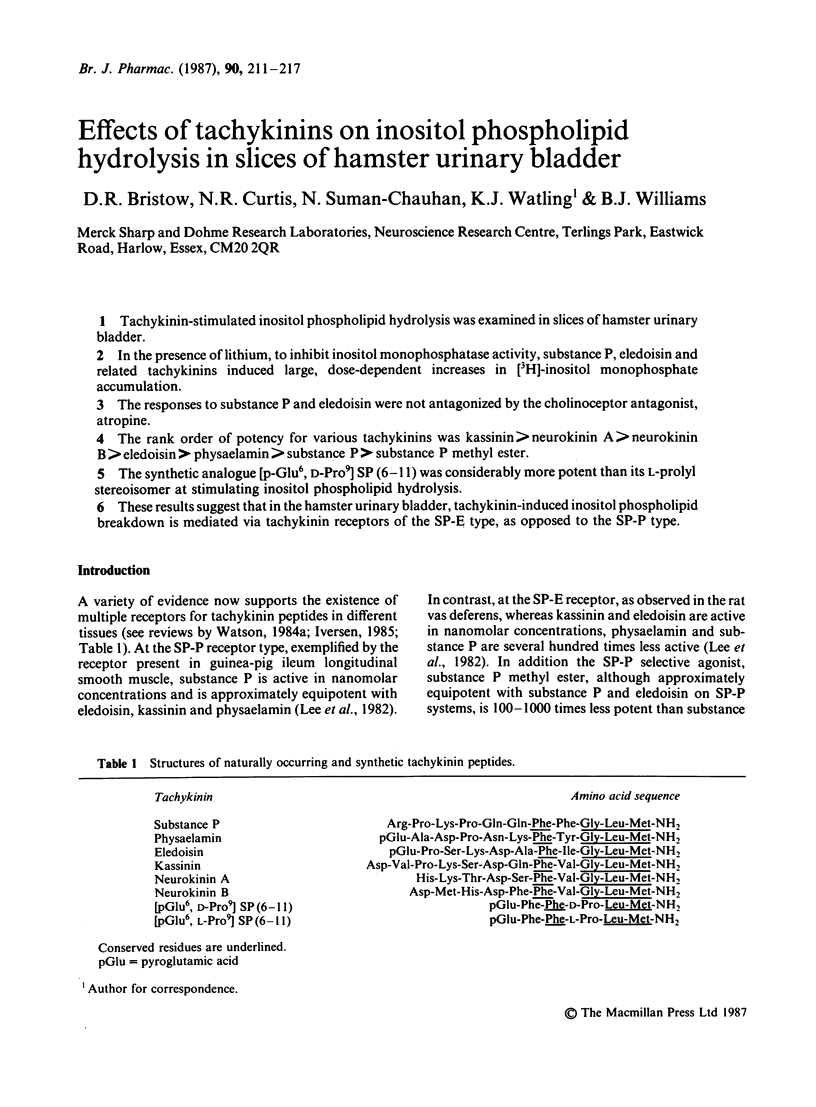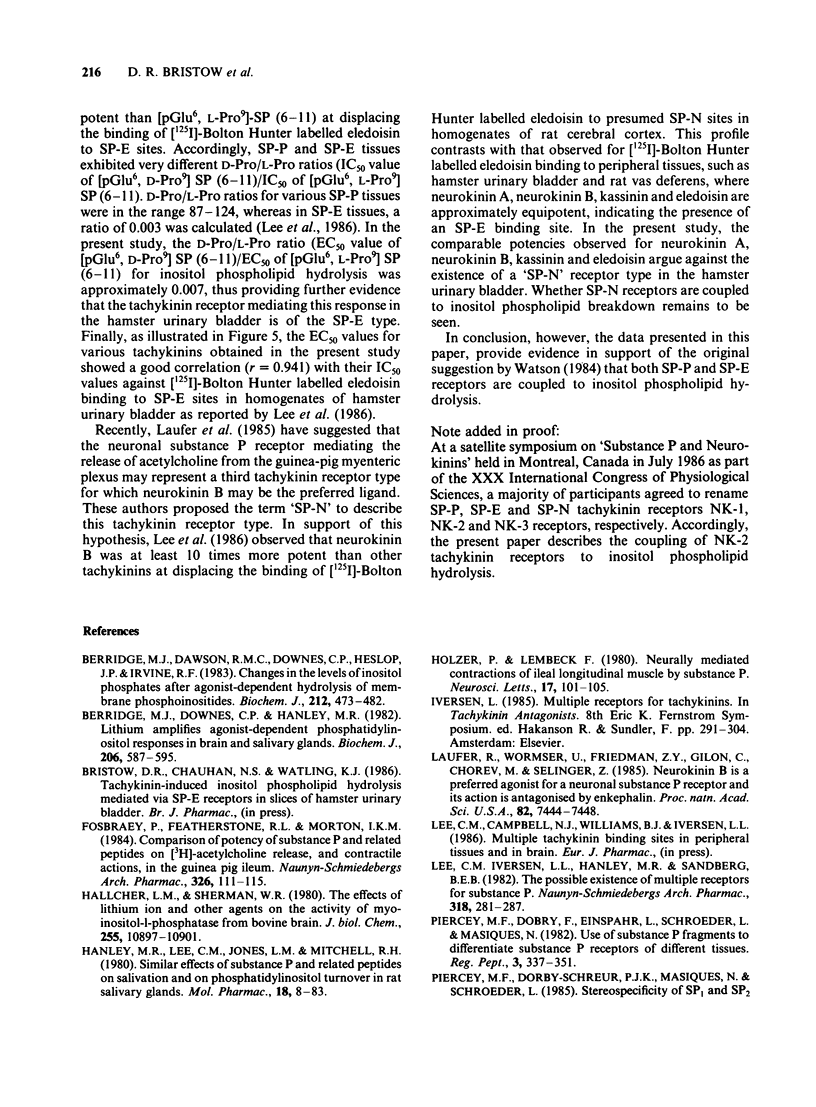Abstract
Tachykinin-stimulated inositol phospholipid hydrolysis was examined in slices of hamster urinary bladder. In the presence of lithium, to inhibit inositol monophosphatase activity, substance P, eledoisin and related tachykinins induced large, dose-dependent increases in [3H]-inositol monophosphate accumulation. The responses to substance P and eledoisin were not antagonized by the cholinoceptor antagonist, atropine. The rank order of potency for various tachykinins was kassinin greater than neurokinin A greater than neurokinin B greater than eledoisin greater than physaelamin greater than substance P greater than substance P methyl ester. The synthetic analogue [p-Glu6, D-Pro9]SP (6-11) was considerably more potent than its L-prolyl stereoisomer at stimulating inositol phospholipid hydrolysis. These results suggest that in the hamster urinary bladder, tachykinin-induced inositol phospholipid breakdown is mediated via tachykinin receptors of the SP-E type, as opposed to the SP-P type.
Full text
PDF






Selected References
These references are in PubMed. This may not be the complete list of references from this article.
- Berridge M. J., Dawson R. M., Downes C. P., Heslop J. P., Irvine R. F. Changes in the levels of inositol phosphates after agonist-dependent hydrolysis of membrane phosphoinositides. Biochem J. 1983 May 15;212(2):473–482. doi: 10.1042/bj2120473. [DOI] [PMC free article] [PubMed] [Google Scholar]
- Berridge M. J., Downes C. P., Hanley M. R. Lithium amplifies agonist-dependent phosphatidylinositol responses in brain and salivary glands. Biochem J. 1982 Sep 15;206(3):587–595. doi: 10.1042/bj2060587. [DOI] [PMC free article] [PubMed] [Google Scholar]
- Fosbraey P., Featherstone R. L., Morton I. K. Comparison of potency of substance P and related peptides on [3H]-acetylcholine release, and contractile actions, in the guinea-pig ileum. Naunyn Schmiedebergs Arch Pharmacol. 1984 Jun;326(2):111–115. doi: 10.1007/BF00517306. [DOI] [PubMed] [Google Scholar]
- Hallcher L. M., Sherman W. R. The effects of lithium ion and other agents on the activity of myo-inositol-1-phosphatase from bovine brain. J Biol Chem. 1980 Nov 25;255(22):10896–10901. [PubMed] [Google Scholar]
- Hanley M. R., Lee C. M., Michell R. H., Jones L. M. Similar effects of substance P and related peptides on salivation and on phosphatidylinositol turnover in rat salivary glands. Mol Pharmacol. 1980 Jul;18(1):78–83. [PubMed] [Google Scholar]
- Holzer P., Lembeck F. Neurally mediated contraction of ileal longitudinal muscle by substance P. Neurosci Lett. 1980 Apr;17(1-2):101–105. doi: 10.1016/0304-3940(80)90069-5. [DOI] [PubMed] [Google Scholar]
- Laufer R., Wormser U., Friedman Z. Y., Gilon C., Chorev M., Selinger Z. Neurokinin B is a preferred agonist for a neuronal substance P receptor and its action is antagonized by enkephalin. Proc Natl Acad Sci U S A. 1985 Nov;82(21):7444–7448. doi: 10.1073/pnas.82.21.7444. [DOI] [PMC free article] [PubMed] [Google Scholar]
- Lee C. M., Iversen L. L., Hanley M. R., Sandberg B. E. The possible existence of multiple receptors for substance P. Naunyn Schmiedebergs Arch Pharmacol. 1982 Mar;318(4):281–287. doi: 10.1007/BF00501166. [DOI] [PubMed] [Google Scholar]
- Piercey M. F., Dobry-Schreur P. J., Masiques N., Schroeder L. A. Stereospecificity of SP1 and SP2 substance P receptors. Life Sci. 1985 Feb 25;36(8):777–780. doi: 10.1016/0024-3205(85)90198-5. [DOI] [PubMed] [Google Scholar]
- Piercey M. F., Dobry P. J., Einspahr F. J., Schroeder L. A., Masiques N. Use of substance P fragments to differentiate substance P receptors of different tissues. Regul Pept. 1982 May;3(5-6):337–349. doi: 10.1016/0167-0115(82)90057-x. [DOI] [PubMed] [Google Scholar]
- Watson S. P., Downes C. P. Substance P induced hydrolysis of inositol phospholipids in guinea-pig ileum and rat hypothalamus. Eur J Pharmacol. 1983 Sep 30;93(3-4):245–253. doi: 10.1016/0014-2999(83)90144-9. [DOI] [PubMed] [Google Scholar]
- Watson S. P., Sandberg B. E., Hanley M. R., Iversen L. L. Tissue selectivity of substance P alkyl esters: suggesting multiple receptors. Eur J Pharmacol. 1983 Jan 28;87(1):77–84. doi: 10.1016/0014-2999(83)90052-3. [DOI] [PubMed] [Google Scholar]
- Watson S. P. The action of substance P on contraction, inositol phospholipids and adenylate cyclase in rat small intestine. Biochem Pharmacol. 1984 Dec 1;33(23):3733–3737. doi: 10.1016/0006-2952(84)90033-9. [DOI] [PubMed] [Google Scholar]
- Yau W. M., Youther M. L. Direct evidence for a release of acetylcholine from the myenteric plexus of guinea pig small intestine by substance P. Eur J Pharmacol. 1982 Jul 30;81(4):665–668. doi: 10.1016/0014-2999(82)90357-0. [DOI] [PubMed] [Google Scholar]


